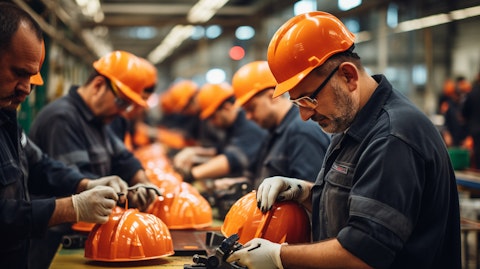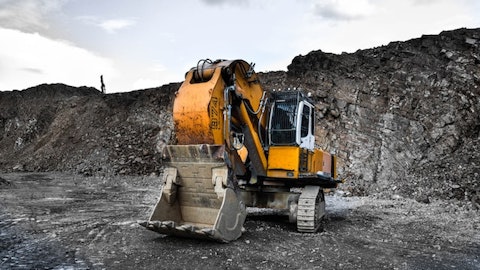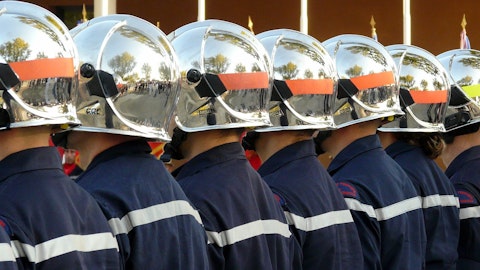MSA Safety Incorporated (NYSE:MSA) Q3 2023 Earnings Call Transcript October 25, 2023
Operator: Good day, and welcome to the MSA Third Quarter 2023 Earnings Conference Call. All participants’ will be in listen-only mode. [Operator Instructions] After today’s presentation, there will be an opportunity to ask questions. [Operator Instructions] Please note, this event is being recorded. I would now like to turn the conference over to Chris Hepler.
Chris Hepler: Thank you. Good morning, and welcome to MSA Safety’s third quarter 2023 earnings conference call. This is Chris Hepler, Executive Director of Corporate Development and Investor Relations. With me today are Nish Vartanian, Chairman and CEO; Steve Blanco, President and COO; and Lee McChesney, Senior Vice President and CFO; Stephanie Sciullo, President of our Americas segment, will be joining us for the Q&A. Before we begin, I’d like to remind everyone that matters discussed during this call may include forward-looking statements within the meaning of the Private Securities Litigation Reform Act of 1995. Forward-looking statements include, but are not limited to, all projections and anticipated levels of future performance.
Forward-looking statements involve a number of risks, uncertainties and other factors that may cause our actual results to differ materially from those discussed today. These risks, uncertainties and other factors are detailed in our SEC filings. MSA Safety undertakes no duty to publicly update any forward-looking statements made on this call, except as required by law. We have included certain non-GAAP financial measures as part of our discussion this morning. The non-GAAP reconciliations are available in the appendix of today’s presentation. The presentation and press release are available on our Investor Relations website at investors.msasafety.com. Moving on to today’s agenda. First, Nish and Steve will discuss key highlights of the quarter.
Lee will then review our financial performance and outlook. And to conclude, Nish will provide closing comments at which time, we will open up the call for your questions. With that, I’ll turn the call over to Nish.
Nish Vartanian: Thanks, Chris. Good morning, everyone, and thank you for your interest in MSA. I’ll start on slide four. Since MSA’s founding in 1914, we’ve been a purpose-driven company, and our mission of safety has been unwavering. The singular focus is fully integrated into our business strategy as reflected by our 2022 impact report published in August, which details our efforts to create shared value for all stakeholders. We live our purpose every day through our three impact pillars. Products and solutions, people and planet. These impact pillars guide our approach to developing the next generation of safety solutions to make work safer, easier and more productive for people everywhere, keeping our own workforce safe and healthy in conducting our business in a sustainable manner.
One way in which we create significant impact and drive value is through continuing to develop innovative products and solutions, such as our connected safety ecosystem and inclusive safety gear to protect diverse workers throughout the world. We continue to evolve our existing product lines by addressing unique safety challenges such as heat stress with solutions like our V-Gard C1 Hard Hat with patent pending reflect IR thermal barrier technology that can lower the temperature inside the Hard Hat by as much as 20 degrees Fahrenheit or our Bacharach multi-zone refrigerant monitor that is used by grocery chains to quickly detect leaks in the cooling systems that keep our food safe. Early detection of leaks also reduces emissions and mitigate safety incidents, which helps our customers meet their own sustainability goals.
Additionally, we also live our purpose by promoting safety within our communities. During the 2023 Tour de France, members of the French Federation of Firefighters on the tour’s emergency response team wore MSA’s Gallet F2XR rescue helmets. And Stage 13 of the tour was hosted by the French city of Chatillon, known as the World Capital of fire helmets, home to our facility that makes the iconic Gallet helmet. We also announced an expanded partnership with the National Hockey League, Pittsburgh Penguins in order to drive broader awareness of our industry-leading safety solutions as the team’s official safety sponsor. The MSA Safety brand will be featured on the team’s away-game helmets and be prominent on game day when the team plays at home at PPG Paints Arena.
Finally, we’re proud to share that MSA’s impact continues to be recognized both locally and nationally. We were just named one of America’s Greenest companies for 2024 by Newsweek and also achieved a top workplace distinction by the Pittsburgh Post-Gazette for the tenth time. These awards are the latest examples of the extensive recognition our team has received for the incredibly important work that we do. I want to thank the entire MSA team for their dedication to our mission, vision and values, as well as to creating the impact that earned us this recognition. I take great pride in our mission and purpose. It’s always a pleasure to see our mission and action when I’m on the road meeting with our associates and customers. I recently spent time with our Latin American team and meeting with customers in the region.
Our team there has made tremendous progress building this region into a very strong, profitable and diversified business across all our product lines. Meeting with associates there, it was energizing to see the team’s commitment to our mission of safety and their enthusiasm for helping to solve our customers’ toughest safety challenges. With that, I’ll now turn the call over to Steve, who will take you through some of the other highlights from the quarter.
Steve Blanco: Thanks, Nish, and good morning. I’m on slide five. Our MSA team achieved strong results in the quarter with double-digit growth, solid margin expansion and robust cash flow generation. We continue to build momentum across our business as a result of healthy market demand and steady progress in our execution, supported by the MSA Business System. Our largest category, firefighter safety, which represents 37% of total sales, has proven to be resilient over the years with stable funding from federal, state and local governments. The pipeline and outlook across our head-to-toe firefighter solutions is strong, and we continue to win business across our key product categories. We recently announced that the Pittsburgh Bureau of Fire has continued its partnership with MSA by upgrading to our leading G1 SCBA as part of a $3.1 million contract award.
In addition, we were awarded a $3.9 million contract for Fresno, California and additional sizable SCBA conversions with customer departments in Georgia. The G1 SCBA is the cornerstone of MSA’s connected firefighter platform with improved connected communication capabilities that provide firefighters and Incident Command with critical information, such as battery life and air pressure for enhanced situational awareness and the ability to easily update as technology changes in the future. We’re also seeing further progress with our M1 SCBA designed for the international markets. Leveraging our recent win with the London Fire Brigade, we announced a $7 million contract in the quarter to supply firefighters from five fire authorities in the United Kingdom with our M1 SCBA and connected firefighter technologies.
In the third quarter, growth in firefighter safety was 20% year-over-year, driven by double-digit growth in both breathing apparatus, as well as firefighter helmets and protective apparel. Our second largest product category, gas detection represents 36% of sales. Our fixed gas and flame detection and portable gas detection solutions are used throughout the world to help protect workers and keep critical infrastructure and the environment safe. These solutions are used in highly regulated applications across a broad range of end markets. There are high barriers of entry across these product categories, supported by our broad patent portfolio, proprietary sensor technologies and increasingly software innovation as part of our connected work platform.

We’ve built our gas detection portfolio through innovation, as demonstrated through our S5000 platforms, as well as our comprehensive lineup of portable gas detectors. Through a series of acquisitions over the last few years, we have expanded our end market exposures to mitigate cyclicality while further diversifying our portfolio into new geographies and complementary technologies to help customers address their unique safety requirements across a broad range of industries. On the portable side, we most recently launched our fully connected ALTAIR io 4 platform. This device leverages MSA’s innovative and proprietary technology, as well as our connected software platform. The io 4 enables customers to increase operational uptime and efficiency and allows them to better manage compliance and maintenance.
In addition, our customers have increased safety visibility through real time and historical monitoring and are able to leverage data to provide robust reporting and analytics that drive proactive safety programs. We continue to be pleased with our growth and the interest from our customers for this new platform. In the third quarter, we saw double-digit growth for both fixed gas and flame detection and portable gas detection, helped in part by an improving supply chain. Fixed gas and flame detection was up 28% year-over-year and portable gas detection grew at 11%. Looking forward, the pipeline and outlook for our gas detection solutions remains solid. Now moving on to industrial PPE, which includes head protection, fall protection and related safety products.
During the third quarter, fall protection sales increased 15% year-over-year and head protection grew by 5%. We saw sizable wins in the quarter with new customers such as our innovative V-TEC io 1 self-retracting lifeline, specifically designed for warehouse applications. While order pace in the quarter was healthy, we continue to watch trends closely across our shorter-cycle product lines as we are seeing varying dynamics across our regions. As such, we continue to be conservative on the near-term outlook for industrial PPE. Before I turn the call over to Lee, I want to thank our associates who have welcomed me with open arms as I’ve stepped into the COO role a few months ago. I continue to be impressed with your commitment to our mission and the passion I have seen from our valued colleagues around the world.
I will now turn the call over to Lee to cover financial results.
Lee McChesney: Thank you, Steve, and good morning, everyone. We appreciate you joining the call today. I will now go into the details of our differentiated performance during the third quarter. Let’s get started on slide six with the quarterly financial highlights. Sales were $447 million, an increase of 17% over the prior year, with positive contributions from each of our businesses and regions. Growth was balanced between unit volume and price in the quarter, and currency translation provided a small benefit as well. Market conditions, demand trends in our commercial pipeline remained solid during the quarter. Year-to-date, our book-to-bill was slightly greater than 1 times. While our backlog remains elevated, compared to historical levels and improving supply chain enabled the team to further reduce backlog in our fixed gas detection in firefighter protective apparel product lines.
We will continue to focus on sustainably reducing our backlog in the coming quarters. Now moving on to margins. Gross profit margin for the third quarter was 49%, up 460 basis points over the prior year and up 120 basis points sequentially. On a GAAP basis, operating margin was 21.1% in the quarter. Adjusted operating margin was 22.7%, up 300 basis points over the prior year. And incremental operating margin in the quarter was 40% at the high end of our target range. Our robust margin performance was driven by strong volume, positive mix and the benefits of the MSA Business System across all elements of the P&L. We continue to be encouraged by the progress we are making on margins across the globe. GAAP net income in the quarter totaled $65 million, or $1.65 per diluted share.
On an adjusted basis, diluted net earnings per share were $1.78, a 23% increase over the prior year. The increase was largely due to higher operating profit, which was partially offset by higher interest expense and a higher effective tax rate in the quarter. Now I’d like to review our segment performance. In our Americas segment, growth was 14% year-over-year and was balanced across our regions and product categories with strength in firefighter safety, gas detection and fall protection. Currency translation was a 2% benefit in the quarter. Adjusted operating margin was 29.9%, and year-over-year margin expansion was largely driven by higher volume, price cost balance and operational improvement. We also had strong results in our International segment.
Growth was 25% year-over-year and balanced across our regions and product categories with strength in fixed gas and flame detection, breathing apparatus and fall protection. Included in the growth was a 4% tailwind from currency translation. Adjusted operating margin was 17%, representing 900 basis points of expansion compared to the prior year period, driven by strong volume leverage, mix benefits, price cost performance and improved operational productivity. Now turning to slide seven on cash flow and leverage. Free cash flow in the quarter was $112 million, representing a conversion rate of 160%. Free cash flow improved year-over-year due to higher earnings and solid execution with working capital. During the quarter, we invested $13 million in CapEx, repaid $68 million in debt and returned $18 million in dividends to our shareholders.
Our financial position continues to strengthen as we progress through the year. Net leverage at the end of the third quarter was 1.3 times trailing EBITDA. We have now repaid $146 million of debt since our divestiture at the start of the year as a result of robust cash generation, profitable growth and disciplined investment strategies. Net debt at the end of the third quarter was $578 million, a sequential reduction of $90 million. Adjusted EBITDA for the trailing 12-month period ended September 30, 2023, was $428 million or 24.7% of net sales. The progress we’re making on cash flow and debt reduction provides us with further flexibility as we consider our capital deployment priorities. Looking forward, we continue to evaluate opportunities to enhance our strategic market position and portfolio of solutions to help protect workers, critical assets and the environment.
Now I’d like to move to our outlook for the remainder of the year on slide eight. We entered the fourth quarter with strong momentum. Our key end markets continue to be healthy, demand trends are supportive and our backlog remains an opportunity. However, the current macroeconomic environment with high interest rates and sustained high levels of inflation is resulting in dynamic operating conditions. With growing uncertainties, we’re remaining agile and focused on the elements within our control. Based on the year-to-date progress and expectations for the fourth quarter, we are raising our outlook for the full year growth to the mid-teens range. Our outlook balances the many opportunities and the risks we’ve seen throughout the year. So to wrap up, we’re pleased with our strong performance in the third quarter and year-to-date, which is a result of our team’s consistent execution, the durability of our business, the strength of our market positions and the resiliency of our end markets.
With that, I’ll now turn the call back to Nish.
Nish Vartanian: Thanks, Lee. Moving to slide nine. We had another quarter of strong results. Our performance demonstrates the strength of our portfolio and our team’s commitment to executing our plan and delivering solutions that enable our customers to operate safely. We entered the fourth quarter with balanced optimism as we continue to carefully monitor the macro environment and adjust as necessary. Looking ahead to the longer term, MSA is well positioned to create sustainable shared value for our stakeholders. Over the past several years, through new product introductions and strategic acquisitions, we’ve evolved our business to be even more resilient and better positioned to deliver sustainable growth. At MSA, we’re driven by our mission and passion for safety.
Our business has proven durable over nearly 110 years. Our innovative solutions serve our customers’ most critical safety needs. We’ve built a diversified portfolio with market-leading positions in firefighter safety, detection and industrial PPE and are poised to deliver sustained growth. The combination of our talented and driven team, differentiated portfolio, resilient end markets and strong balance sheet positions us to continue delivering sustained shareholder value in the future. With that, I’ll turn the call back over to the operator for a Q&A.
See also 30 Heavily Indebted Poor Countries and 10 Best Live TV Streaming Services for Cord Cutters in 2023.
Q&A Session
Follow Msa Safety Inc (NYSE:MSA)
Follow Msa Safety Inc (NYSE:MSA)
Operator: [Operator Instructions] Our first question comes from Stanley Elliott from Stifel. Please go ahead.
Stanley Elliott: Hey, good morning, everyone. Congratulations and thanks for the question.
Nish Vartanian: Thanks, Stanley.
Stanley Elliott: Nish, I guess starting off, maybe talk a little bit about the margins. I mean if you go back pre-COVID you guys were, let’s call it, a 45% gross margin. You guys are tracking 47% plus right now. Is that all mix? Is that price? Maybe help us with some of the things you’re doing structurally to drive the margins higher on this?
Nish Vartanian: Sure, Stanley. I’ll kick things off and Lee will give some more color on that. As you know, we’ve really focused on continuous improvement and operational improvement in the organization. We worked hard to offset inflation and that cost price balance has worked a bit in our favor. And obviously, we’ve had some mix help in the quarter and some nice improvement there. But I’ll let Lee provide a little more color on what’s transpired here.
Lee McChesney: Yes. Stanley. So I think Nish gave you a good entry point there, really, for the last several years, we’ve been focusing on gross margin. And I think win number one was to navigate whether it was incredible inflation levels, FX or just the supply chain challenges of COVID. And I think we won there and keeping the gross margin in many cases, in that 44% to 45% range despite those obstacles. And it’s the full suite that we talked about in the business system. So obviously, pricing, excellence, operational productivity, the things we’ve done in SG&A just to become more efficient. If you then pivot to where we are today, all those efforts are still continuing and probably even gaining a little bit of momentum. And we don’t have — we actually have a favorable FX number this quarter.
And we don’t have to manage as much on the cost. I mean, certainly, there’s still inflation out there. It’s sustaining itself. There’s obviously pluses and minuses. But we’re managing through that with things like productivity as well. So I think as you look forward, this 47% to 48% zone is probably a good baseline. I’d also say — make sure we keep volume in mind. Obviously, there’s volume has helped, mix has helped. So if those were to pivot the wrong way, we get some pressure there. But we’re comfortable with where we are, and we want to keep building from here.
Stanley Elliott: And I guess kind of carrying that on the margin piece to the international nearly 900 points or more. How much of that — I know you’ve been working on the manufacturing side and on the cost outside. Just trying to think of what is the new run rate for that business was assuming volumes kind of stay in the same level that they are, how should we think about that overall profitability in the International segment?
Lee McChesney: Yes. It’s a good question. Well, we’ve made progress that business for a period of time was just below double digits, and we’ve got a broad effort to improve that. I do think as you look forward, the business right now is probably in the mid-teens. When all things go well, you certainly have a nice mix benefit, good volume benefit this quarter. That helps. But I think we are in that zone. And just like we talked about overall for MSA, we want to keep building from there. I will remind you that there is a little bit of anomalies 3Q and 4Q for international. Last year, we had a bit of a softer third quarter and a really strong fourth quarter. So it’s probably good to look at that from a total half perspective as we go forward here as well. But we’re really happy with the progress we’ve made there. The team is focused on the right things. I mean it does speak to really the business system, I think, continuing to grow its routes globally for MSA.



